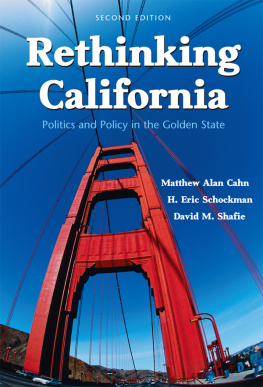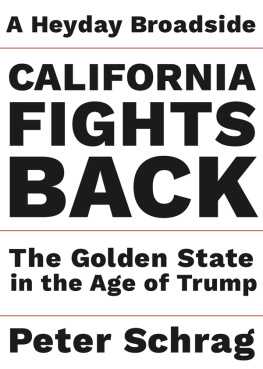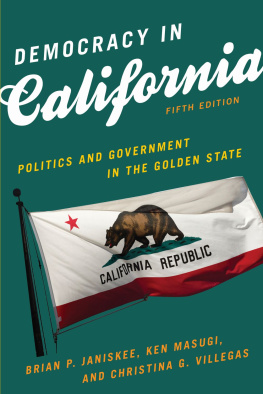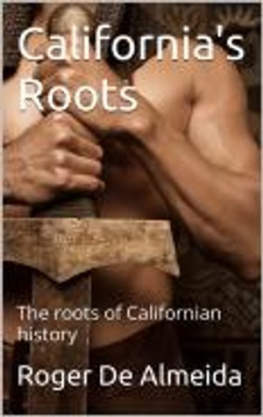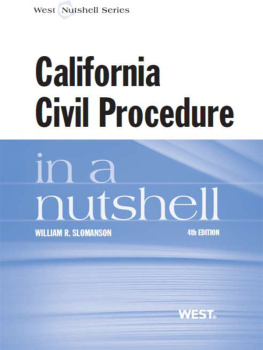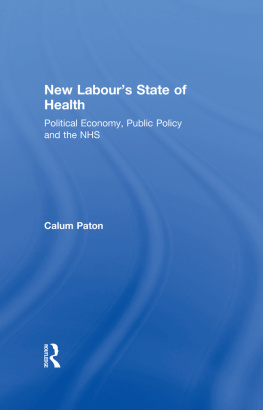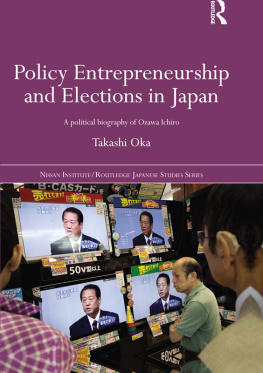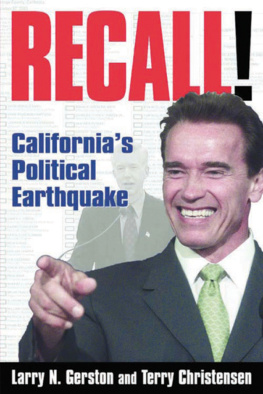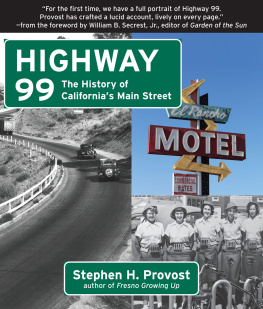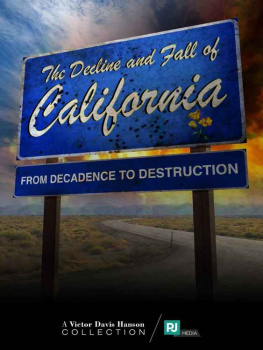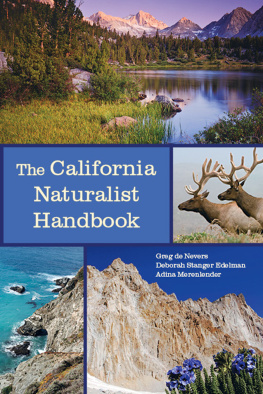Why Do You Need This New Edition?
If youre wondering why you need this new edition of Rethinking California here are five good reasons!
1. A discussion of the 2009 economic crisis analyzes the factors that led to the budget fiasco and looming bankruptcy of the state.
2. Simmering problemsan ideologically prepared legislature, widespread bureaucracy, underfunded schools, overcrowded prisons, and dilapidated infrastructureand the demand for an overhaul of Californias constitution to address these issues are covered in detail.
3. An analysis of the politics and mechanics of the recall of Governor Gray Davis and the election of Arnold Schwarzenegger is included.
4. A new chapter on direct democracy offers an expanded discussion of the initiative, the referendum, and the recall and considers why they figure so prominently in California politics.
5. A fresh array of contemporary and historical readings from literature, essays, and political biographies appear in each chapter, illustrating Californias unique political culture.
First published 2010, 2001 by Pearson Education, Inc.
Published 2016 by Routledge
2 Park Square, Milton Park, Abingdon, Oxon OX14 4RN
711 Third Avenue, New York, NY 10017, USA
Routledge is an imprint of the Taylor & Francis Group, an informa business
Copyright 2010, 2001 Taylor & Francis. All rights reserved.
All rights reserved. No part of this book may be reprinted or reproduced or utilised in any form or by any electronic, mechanical, or other means, now known or hereafter invented, including photocopying and recording, or in any information storage or retrieval system, without permission in writing from the publishers.
Notice:
Product or corporate names may be trademarks or registered trademarks, and are used only for identification and explanation without intent to infringe.
Credits and acknowledgments borrowed from other sources and reproduced, with permission, in this textbook appear on appropriate page within text.
ISBN: 9780131842922 (pbk)
Cover Designer :Wendy Ann Fredericks
Library of Congress Cataloging in Publication Data
Cahn, Matthew Alan
Rethinking California: politics and policy in the golden state / Matthew Alan Cahn, H. Eric Schockman, David M. Shafie. 2nd ed.
p. cm.
Includes bibliographical references and index.
ISBN-13: 978-0-13-184292-2 (alk. paper)
ISBN-10: 0-13-184292-7 (alk. paper)
1. Political planningCalifornia. 2. Political cultureCalifornia. 3. CaliforniaPolitics and government. I. Schockman, H. Eric. II. Shafie, David M. III. Title.
JK8749.P64C34 2010
Contents
CHAPTER 1
THE THREE STATES OF CALIFORNIA: AN INTRODUCTION
FEATURED READING: by Joan Didion
CHAPTER 2
CALIFORNIAS POLITICAL HISTORY
FEATURED READING: by Ruben Martinez
CHAPTER 3
POLITICAL CULTURE AND POLITICS IN POSTWAR CALIFORNIA
FEATURED READING: A Supermarket in California by Allen Ginsberg
CHAPTER 4
PEOPLE, DIVERSITY, AND CULTURE
FEATURED READING: A Different Mirror by Ronald Takaki
CHAPTER 5
CALIFORNIAS POLITICAL ECONOMY
FEATURED READING: by Jocelyn Lippert
CHAPTER 6
CALIFORNIAS CONSTITUTION AND CONSTITUTIONAL OFFICERS
FEATURED READING: by Daniel Weintraub
CHAPTER 7
CALIFORNIAS LEGISLATURE
CHAPTER 8
CALIFORNIA JUSTICE
FEATURED READING: by Lori Cox Han
CHAPTER 9
INTERGOVERNMENTAL RELATIONS
FEATURED READING: by Gar Alperovitz
CHAPTER 10
THE POLICY GAME
FEATURED READING: by Gary Delsohn and Margaret Talev
CHAPTER 11
NON-INSTITUTIONAL PLAYERS: THE MEDIA, POLITICAL PARTIES, AND INTEREST GROUPS
FEATURED READING: by Jordan Rau
CHAPTER 12
THE ELECTORATE AS PLAYERS: ELECTIONS AND POLITICAL PARTICIPATION
CHAPTER 13
EDUCATION POLICY
FEATURED READING: by Susan E. Brown
CHAPTER 14
ENVIRONMENTAL AND ENERGY POLICY
FEATURED READING: by Barry Commoner
CHAPTER 15
IMMIGRATION POLICY
FEATURED READING: by George W. Bush
CHAPTER 16
CIVIL RIGHTS POLICY
by Tom Brokaw
CHAPTER 17
RETHINKING CALIFORNIA
FEATURED READING: by Philip K. Dick
APPENDIX A
CALIFORNIAS COUNTIES
APPENDIX B
CALIFORNIA RESOURCES ON THE WEB
Early in 2009, hundreds of citizens gathered in a hotel ballroom in Sacramento and calmly discussed a radical idea: a complete overhaul of Californias constitution. The meeting came on the heels of a protracted budget crisis that left the state without cash for its payroll. Several state offices, including the Department of Motor Vehicles, were shut down temporarily to conserve funds, and employees were forced to take furloughs. The budget dispute eventually ended when Governor Arnold Schwarzenegger and the state legislature struck a deal to cut spending and raise some taxes and fees, but that solution did not satisfy the group of business and labor leaders, teachers, public interest group members, and concerned citizens that had gathered in Sacramento.
The group called for nothing less than a constitutional convention, to be initiated at the ballot box unless the legislature acted first. This had become necessary, they argued, because the states executive leadership, bureaucracy, and ideologically polarized legislature had been unable to solve a host of simmering problems. Besides the budget fiasco, there were underfunded schools, overcrowded prisons, and an infrastructure in tatters. Californias government was broken, they declared, and the only solution was to throw out the 130-year-old document and begin anew.
The forum was a sign of the growing frustration over the failure of government institutions to meet the challenges of the largest and most diverse state, the largest agricultural producer and home to the largest urban population, a state with extreme concentrations of wealth and poverty, the worlds eighth-largest economy. The once-utopian Golden State was facing serious problems.
Much has happened since the first edition of this book appeared. The recall election of Governor Gray Davis was the kind of spectacle that could happen only in California. Using the instrument of direct democracy, a well-funded group forced a special election to remove an unpopular governor less than one year into his second term, replacing him with a Venice Beach bodybuilder-turned-movie star. The record $43 billion deficit that Schwarzenegger faced at the end of 2008 was even larger than the gap in the states finances that sparked the recall of his predecessor.
The second edition of Rethinking California features a number of additions, including a discussion of the politics and the mechanics of the recall. A new chapter on direct democracy includes an expanded discussion of the initiative, the referendum, and the recall, and it considers why they figure so prominently in California politics. Finally, this new edition features supplemental readings from a variety of sources. These selections from literature, essays, and political biographies in each chapter add lively contemporary and historical voices to our treatment of the subjects.
This book is dedicated to our families: Ann, Tara, Diane, Arlo, Tobin, Jonah, and Steven.
Matthew Alan Cahn
H. Eric Schockman
David M. Shafie
No book is the work of its authors alone. We would like to thank several people for their insights into the California experience. They include Tim Hodson at the Center for California Studies (CSU Sacramento), Jaime Regalado at the Pat Brown Institute (Cal State, Los Angeles), Fernando Guerra at the Center for the Study of Los Angeles (Loyola, Marymount), and Tom Hogen-Esch, Martin Saiz, and Larry Becker in the Department of Political Science at Cal State Northridge. We would also like to thank the reviewers who provided their scholarly analysis of this new edition: Damon Conklin (Golden Gate University) and Sean Q. Kelly (California State UniversityChannel Islands).

